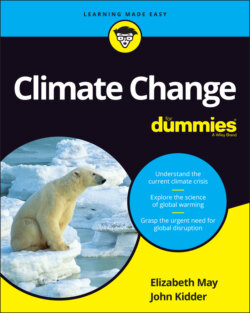Читать книгу Climate Change For Dummies - Elizabeth May - Страница 27
Polar regions
ОглавлениеThe planet’s polar regions are feeling climate change’s effects more intensely than anywhere else in the world. Warming temperatures are melting the ice and thawing the permafrost (the permanently frozen layer of earth in northern regions of Alaska, Canada, and Siberia) that used to be solid ground.
The Arctic is home to many changes brought on by global warming, including the following:
Lost traditions: Some indigenous people who make their homes in the Arctic are having to abandon their traditional ways of life. The Arctic ice and ecosystem are both core to many of these people’s cultures and livelihoods. For more on this issue, flip ahead to Chapter 9.
Melting ice: The Greenland ice sheet is melting, adding to sea level rise. Arctic ice is also steadily losing ice volume. All of this melting is diluting ocean waters and affecting ocean currents.
New plant life: Greenery and new plants have been appearing in the Arctic in recent years. The tree line (where tree growth use to end and tundra began) is shifting farther north, but the soil isn’t there to support a forest. Soils and ecosystems take thousands of years to develop — the changes happening now are rapid and unpredictable.
Some people look forward to the changes that the Arctic is experiencing. Now that so much sea ice has melted, ships can navigate the Arctic Ocean more efficiently, taking shorter routes. Without any sense of irony, oil companies now keenly anticipate being able to reach more fossil fuels below what used to be unreachable areas because of ice cover. Communities in the Arctic may be able to harness river flows that have been boosted or created by ice melt to run hydroelectric power. But these short-term economic developments can’t outweigh the negative planetary impacts.
In the Antarctic, some scientists project major change because of global warming, thinking there’s a chance that the western Antarctic ice sheet might collapse by the end of the 21st century. The western Antarctic ice sheet is simply enormous. It contains about 768,000 cubic miles (3.2 million cubic kilometers) of ice, about 10 percent of the world’s total ice. It appears to be weakening because warmer water is eroding its base. For the first time in the 2021 Sixth Assessment Report, IPCC scientists accepted as plausible, but not likely, that the entire sheet could melt. The Greenland ice sheet is also melting — quickly. Both the western Antarctic and Greenland ice sheets are adding to sea level rise.
The melting polar ice is also endangering many species, such as polar bears and penguins, which rely on the ice as a hunting ground. (Chapter 8 offers more information about the ways the polar animals are being affected by global warming.)
